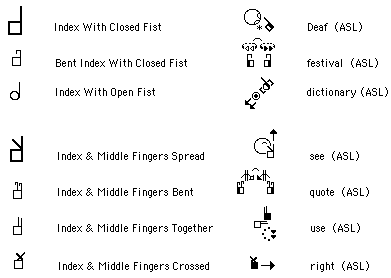|
COMPARISON continued...
2. Hand Shape
Hand Shape most clearly shows the difference between the schematics
of SSW and the taxonomic approach of SN. The traditional taxonomic
approach establishes a limited number of distinct shapes and
gives each one a symbol. To write a Sign one looks at the whole
hand shape, matches it with whichever one of the set it resembles
most, and gives it that symbol. In contrast, the schematic approach
used by SSW doesn't care how many shapes there are, as it represents
each little part of the hand independently. For a new shape,
SSW merely reproduces it, while SN is forced to put it with one
of the existing symbols, even if it doesn't quite match.
For the Hand Shape parameter SN chose arbitrary shapes, the letters
of the ASL manual alphabet and number system. This is natural
enough and serves a mnemonic function but of course is a problem
when applied to languages other than ASL. The hand shape used
in ASL for <F> is used to represent <T> in Dutch
Sign, in Sweden the hand shape for <B> is that of ASL's
<A>, and in many cultures the ASL <F> is an obscene
gesture (Miller 199). What's more, some signed languages have
no manual alphabet at all (Chinese), or completely different
ones (England, Australia). For them these letters are truly arbitrary,
and of course, for children just learning to read, they are a
burdensome task to memorize. The schematic alternative of SSW
eliminates all these problems (Figure 9a).
Figure 9a:
SSW Hand Shapes are schematic
diagrams
 |
SN kept the number of hand shapes down to 19 by such devices
as treating the <A>, <S>, and <T> as one hand
shape. Stokoe has been criticized for this as these three are
clearly distinctive, and others have found many more distinctive
hand shapes in ASL: Battison found 45, Klima about 40, Newkirk
54 (Valli & Lucas 185), and Johnson and Liddel 150 (Liddell
& Johnson 223). I think Stokoe merely erred on the side of
a popular script. "A hundred and fifty letters is more than
we'd want," was his apparent assumption.
In SSW the number of hand shapes is effectively the number
of positions the hand can take. The symbols are really 2-3 line
segments per digit that join each other and the palm straight
or at angles depending on the positions of the bones. The many
thousands of possible combinations are organized into ten groups
that correspond to the ASL numbers 1-10, and within each group
the fingers can be crossed in four or five ways, the thumb bent
out or straight in either of three planes and so on (Figure 9b).
Figure 9b:
SSW has a different symbol for each hand position
 |
How much phonetic detail can these scripts show? As we have seen
the original SN has proven inadequate in this respect, and I
think Wilbur's criticism still holds for later versions. Although
there is virtually no published discussion of SSW, it fares much
better, at least as regards hand shape. Of the many feature analyses
of ASL, perhaps the most ambitious is the work of Johnson and
Liddell at Gallaudet University. Although their study deals in
detail only with Hand Shape, SSW seems able to show every phonetic
contrast they describe.
|

